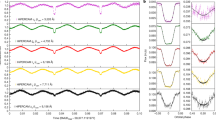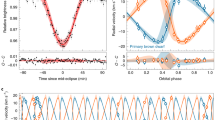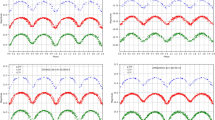Abstract
Stellar pulsation theory provides a means of determining the masses of pulsating classical Cepheid supergiants—it is the pulsation that causes their luminosity to vary. Such pulsational masses are found to be smaller than the masses derived from stellar evolution theory: this is the Cepheid mass discrepancy problem1,2, for which a solution is missing3,4,5. An independent, accurate dynamical mass determination for a classical Cepheid variable star (as opposed to type-II Cepheids, low-mass stars with a very different evolutionary history) in a binary system is needed in order to determine which is correct. The accuracy of previous efforts to establish a dynamical Cepheid mass from Galactic single-lined non-eclipsing binaries was typically about 15–30% (refs 6, 7), which is not good enough to resolve the mass discrepancy problem. In spite of many observational efforts8,9, no firm detection of a classical Cepheid in an eclipsing double-lined binary has hitherto been reported. Here we report the discovery of a classical Cepheid in a well detached, double-lined eclipsing binary in the Large Magellanic Cloud. We determine the mass to a precision of 1% and show that it agrees with its pulsation mass, providing strong evidence that pulsation theory correctly and precisely predicts the masses of classical Cepheids.
This is a preview of subscription content, access via your institution
Access options
Subscribe to this journal
Receive 51 print issues and online access
$199.00 per year
only $3.90 per issue
Buy this article
- Purchase on Springer Link
- Instant access to full article PDF
Prices may be subject to local taxes which are calculated during checkout




Similar content being viewed by others
References
Christy, R. F. The theory of Cepheid variability. Q. J. R. Astron. Soc. 9, 13–39 (1968)
Stobie, R. S. Cepheid pulsation–III. Models fitted to a new mass-luminosity relation. Mon. Not. R. Astron. Soc. 144, 511–535 (1969)
Cox, A. N. The masses of Cepheids. Annu. Rev. Astron. Astrophys. 18, 15–41 (1980)
Gieren, W. Towards a reconciliation of Cepheid masses. Astron. Astrophys. 225, 381–390 (1989)
Bono, G., Gieren, W., Marconi, M., Fouquè, P. & Caputo, F. Improving the mass determination of Galactic Cepheids. Astrophys. J. 563, 319–324 (2001)
Evans, N. R. et al. Direct detection of the close companion of Polaris with the Hubble Space Telescope. Astron. J. 136, 1137–1146 (2008)
Evans, N. R. in Stellar Pulsation: Challenges for Theory and Observation (eds Guzik, J. A. & Bradley, P. A.) 69–72 (AIP Conf. 1170, American Institute of Physics, 2009)
Udalski, A. et al. The Optical Gravitational Lensing Experiment. Cepheids in the Magellanic Clouds. IV. Catalog of Cepheids from the Large Magellanic Cloud. Acta Astron. 49, 223–317 (1999)
Alcock, C. et al. The MACHO Project Large Magellanic Cloud variable star inventory. XII. Three Cepheid variables in eclipsing binaries. Astrophys. J. 573, 338–350 (2002)
Soszynski, I. et al. The Optical Gravitational Lensing Experiment. The OGLE-III catalog of variable stars. I. Classical Cepheids in the Large Magellanic Cloud. Acta Astron. 58, 163–185 (2008)
Wilson, R. E. & Devinney, E. J. Realization of accurate close-binary light curves: application to MR Cygni. Astrophys. J. 166, 605–620 (1971)
Van Hamme, W. & Wilson, R. E. Third-body parameters from whole light and velocity curves. Astrophys. J. 661, 1129–1151 (2007)
Gieren, W., Fouqué, P. & Gómez, M. Cepheid period-radius and period-luminosity relations and the distance to the Large Magellanic Cloud. Astrophys. J. 496, 17–30 (1998)
Lepischak, D., Welch, D. L. & van Kooten, P. B. M. The nature of the companion to the eclipsing overtone Cepheid MACHO 81.8997.87. Astrophys. J. 611, 1100–1106 (2004)
Soszynski, I. et al. The Optical Gravitational Lensing Experiment. The OGLE-III catalog of variable stars. II. Type II Cepheids and anomalous Cepheids in the Large Magellanic Cloud. Acta Astron. 58, 293–312 (2008)
Bono, G., Castellani, V. & Marconi, M. Classical Cepheid pulsation models. III. The predictable scenario. Astrophys. J. 529, 293–317 (2000)
Luck, R. E., Moffett, T. J., Barnes, T. G. & Gieren, W. P. Magellanic Cloud Cepheids–abundances. Astron. J. 115, 605–634 (1998)
Keller, S. C. Cepheid mass loss and the pulsation-evolutionary mass discrepancy. Astrophys. J. 677, 483–487 (2008)
Neilson, H. R. & Lester, J. B. On the enhancement of mass loss in Cepheids due to radial pulsation. Astrophys. J. 684, 569–587 (2008)
Acknowledgements
This work was supported by the Chilean Center for Astrophysics FONDAP, the BASAL Centro de Astrofisica y Tecnologias Afines (CATA), NSF, the Polish Ministry of Science, the Foundation for Polish Science (FOCUS, TEAM), and the GEMINI-CONICYT Fund. The OGLE project has received funding from the European Research Council (‘Advanced Grants’). We thank the staff astronomers at Las Campanas and ESO La Silla who provided support in the data acquisition. We also thank D. Queloz, S. Udry and C. Lovis for their help in reducing and analysing the radial-velocity data obtained with the HARPS instrument.
Author information
Authors and Affiliations
Contributions
G.P., photometric and spectroscopic observations and reductions, data analysis; I.B.T., spectroscopic observations and reductions, radial-velocity measurements, data analysis; W.G., spectroscopic observations, data analysis; D.G., spectroscopic observations, modelling, data analysis; G.B., theoretical models; A.U., photometric observations and reductions, data analysis; I.S., photometric observations and reductions; D.M., spectroscopic observations; B.P., modelling. G.P. and W.G. worked jointly to draft the manuscript, with all authors reviewing and contributing to its final form.
Corresponding author
Ethics declarations
Competing interests
The authors declare no competing financial interests.
Rights and permissions
About this article
Cite this article
Pietrzyński, G., Thompson, I., Gieren, W. et al. The dynamical mass of a classical Cepheid variable star in an eclipsing binary system. Nature 468, 542–544 (2010). https://doi.org/10.1038/nature09598
Received:
Accepted:
Published:
Issue Date:
DOI: https://doi.org/10.1038/nature09598
This article is cited by
-
Weighing stars from birth to death: mass determination methods across the HRD
The Astronomy and Astrophysics Review (2021)
-
High-precision distance measurements with classical pulsating stars
Journal of Astrophysics and Astronomy (2020)
-
Modern Geometric Methods of Distance Determination
Space Science Reviews (2017)
-
Young and Intermediate-Age Distance Indicators
Space Science Reviews (2017)
Comments
By submitting a comment you agree to abide by our Terms and Community Guidelines. If you find something abusive or that does not comply with our terms or guidelines please flag it as inappropriate.



